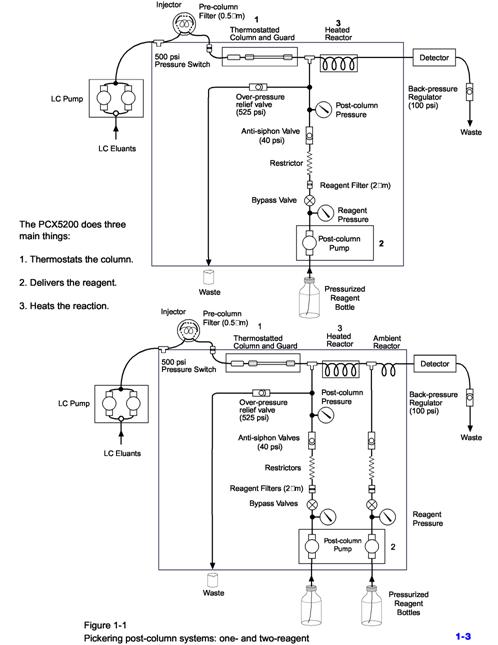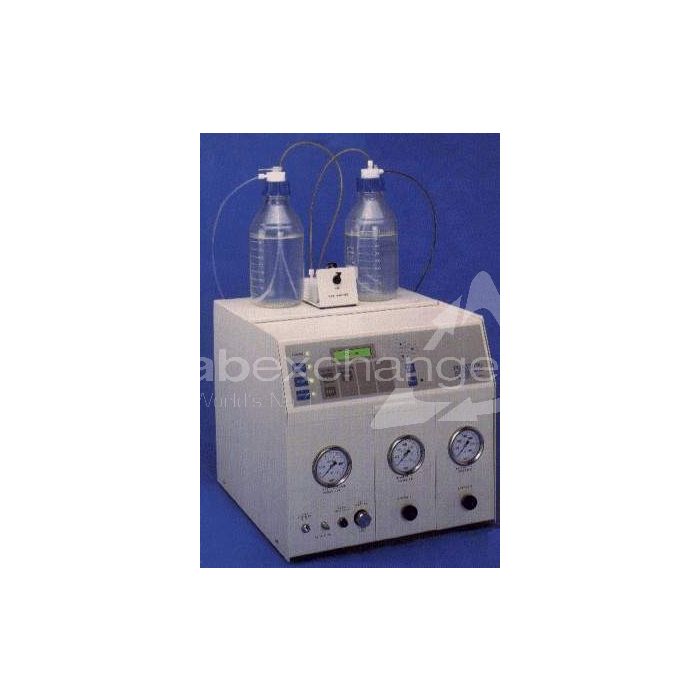Pickering PCX 5200
| Objektnummer | B00014962 |
|---|---|
| ID-number | 014962 |
| Object name | Pickering PCX 5200 |
| Status | Stock unit |
Product group: HPLC-Miscellaneous
Status, terms of delivery and payment
Verification of devices
The second-hand devices are verified by Labexchange Service GmbH before delivery. You are receiving only fully functional devices.
Dispatch time
The stated dispatch times are the shortest possible ones for each article. The effective dispatch times can vary. The effective dispatch times will be stated in the order confirmation.
As a matter of principle, we are offering collective deliveries. The shipping time is calculated based on the position with the longest lead time. A partial delivery is possible on explicit request.
Shipping methods
Parcel services, forwarding agencies, self-pickup, delivery by Labexchange fleet.
Delivery information
Prices exclude shipping costs. Stated shipping costs are to be expected. Deviations are possible. If transport costs are not specified, please ask separately for them.
The stated transport and packing charges apply to the most favorable route if transport and are to be understood as subject to verification due to unexpected cost increases. By reason of unpredictable events, cargo rates and delivery times can change at any time and therefore have to be adapted to the recent situation. Import formalities and possible customs charges will be borne by the purchaser. Incoterm coding according to Incoterms 2010: For persons who collect the devices themselves: EXW, for dipatch by sea: CFR, by air freight: CPT, other shipments: DAP. Note for international shipments: A proof of preference/EUR1 will not be issued by us. When self-collecting/ordering EXW from countries within or outside the European Union, 16% VAT will be retained as a deposit until we have received the corresponding confirmation of arrival/bill of delivery from the buyer.
Terms of payment
We do not accept payment by letter of credit, PayPal, etc. In each case the invoice amount is payable without deduction. Discount is not granted.
|
Country |
Possible payment methods |
Comment |
|
DE, AT, CH |
Payment by invoice, payment in advance, paymet by credit card |
Payment by invoice is only possible for corporate clients. |
|
NL, BE, LU |
Payment by invoice, payment in advance, payment by credit card |
Payment by invoice is only possible for corporate clients |
|
Other countries |
Payment in advance, payment by credit card |
|
Our General Terms of Sale, Delivery and Payment are valid and are available for download here.
The goods are offered subject to prior sale.
Definition of status
All articles are used articles, except an article is listed especially as a new device.
|
Status |
Condition |
Comment |
|
Immediately available |
Used | The article is fully functional and in impeccable condition. It can be shipped immediately. |
| In stock |
Used |
The article is on stock. Our service technicians will verify the article before delivery. You are receiving only a fully functional article. |
|
Published |
Used |
The article is still with the provider. After your order the article will be purchased and verified by us before being shipped to you. A certificate of operativeness as well as a service report are included in delivery. |
|
New device |
new |
The article is brand new and unused. Regarding new equipment the guarantee/warranty conditions of the corresponding manufacturer apply. |
|
Labprocure |
Used |
Labprocure GmbH, as the advertiser, is responsible for the content of this device offer. Labprocure assumes liability for the offers advertised here and for the photos and offer texts included. Labprocure GmbH, Bruckstraße 58, 72393 Burladingen. |
model : PCX 5200
annotation : Dokumente engl .
The following illustrations and descriptions refer to the instrument model and are drawn from brochures. They do not represent the scope of delivery. Please refer to the text of the offer for the exact scope of delivery.

Why Post- coIumn Derivatization ?
Post-column derivatization , also known as post-column reaction, renders visible certain compounds that are normally invisible. This trick is accomplished after the separation by performing a chemical reaction on the substances that gives them an easily detectable physical property. Typically you use a reaction that produces a strong color or makes a fluorescent product. You can increase the sensitivity of detection by several orders of magnitude in favorable cases. Most reagents are selective for a particular class of substances, so analytes of that class are more easily seen against a complex background. So, post-column derivatization is used to increase sensitivity and selectivity in HPLC analysis.
How Does It Work?
The post-column reaction system mixes the stream of effluent flowing from the HPLC column with a stream of reagent solution. The mixture usually flows through a reactor to allow enough time for the chemical reactions to complete. If the reaction is slow, the reactor may be heated to speed things up. Some reactions need two or more reagents added in sequence. Finally, the mixed streams pass into the detector, typically UV/VIS absorbance or fluorescence. Of course, a practical system requires metering pumps, pulse damper, thermostats, and safety systems to give reliable results.
What Are the Requirements?
- Stability of Reagent. The minimum reagent stability sufficient for routine work is one day. This means that the yield and signal-to-noise ratio for a given sample must remain constant for at least 8 hours.
- Speed of Reaction. The analytical separation is complete when the reagent is mixed with the column effluent. Therefore, in order to minimize band spreading, it is important to keep the time (therefore volume) small between the mixing tee and the detector. If the reaction is slow (in excess of one minute), an elevated temperature can be used to decrease the reaction time.
- Reproducibility. Because the reaction is occurring on the fly, as the combined column and reagent stream flows toward the detector, the reproducibility is linked to the flowrate precision of the pumps and to the temperature. Accordingly, even an incomplete reaction will be as repeatable as the retention time for any given species. The completeness of the reaction, then, is not strictly necessary for reproducibility, but it is important for maximum sensitivity.
- Minimal Detector Response of Reagents. The color or background fluorescence of the reagent (or its by-products) represents a continuous noise source. Because the reagent is present in excess relative to the analyte , the analytes signal could be obliterated by the reagents strong background signal. The baseline noise is proportional to the background signal.
- Solubility. All species must remain in solution, including the combined components of the eluants and the reagent(s), as well as the newly formed derivative(s). Precipitates can block capillary tubes, burst reactors, and foul detector flowcells .
- Uniformity of flow. The baseline noise is a function of the flow-noise in the eluant and reagent pumps. Non-uniform flow causes non-uniform mixing leading to modulation of the background signal which appears as noise. Refractive index noise can be even more objectionable than absorbance noise.
The PCX5200 does three main things (Figure 1-1):
1. Thermostats the analytical column
2. Delivers the reagent
3. Heats the reaction.
It also has various features to make the analysis more convenient or reliable, and features to protect the instrument itself from accidental damage.
Reagent Delivery
The pressurized reservoir serves two purposes:
1. It protects air-sensitive reagents from oxidation.
2. It helps the metering pump fill consistently by preventing cavitation .
The pump is a constant speed, variable-stroke piston pump. The cam cycle is two seconds, which makes for easy pulse damping.
The reagent pressure gauge does two things:
1. It shows the pump pressure for diagnostic purposes.
2. It absorbs pulses by the spring action of the Bourdon tube. There is a packed-bed restrictor just downstream to provide a load for the pressure gauge so that it will effectively absorb pulsations.
Referring to Fig. 1-1, the anti-siphon valve prevents the gas pressure in the reservoir from forcing liquid through the system with the power off. The post-column pressure gauge is primarily there to monitor the condition of the reactor. There is a 500 psi relief valve in case there is a blockage in the reactor or detector. The standard reactor is a PTFE capillary tube 0.011˝ I.D. wrapped on a heated mandrel. The narrow diameter reduces band-spreading, and the PTFE is corrosion resistant. There is a 100 psi (5 bar ) back-pressure regulator on the exit line from the detector; it suppresses boiling inside the hot reactor and prevents bubbles from forming in the detector flowcell .
Column Protection
Usually, the post-column reagent will immediately damage the analytical column. To prevent this, there is a pressure switch connected between the HPLC pump and the injector that must sense 500 psi (35 bar ) before allowing the reagent pump and reactor to receive power. If at any time pressure is lost because of fault or programmed shutdown, the PCX5200 will gracefully shut itself off until a human turns it back on.

Specifications
Wetted Materials
PCX5200
316 Stainless steel
17-4 PH Stainless steel
FEP
Saran PVDC
Hastelloy -C
Kel -F CTFE
PEEK
Viton
Borosilicate glass
Sapphire
UHMW polyethylene
PCX5200 PEEK
316 Stainless steel
17-4 PH Stainless steel
Viton
FEP
Saran PVDC
Kel -F CTFE
PEEK
Tefzel ETFE
Borosilicate glass
Sapphire
UHMW polyethylene
Ratings
Dimensions: 37 cm x 38 cm x 38 cm (h x w x d)
Weight: 13 to 15 kg, depending on configuration
Electrical Power: 100120 V; 50/60 Hz; 1.7 A; 200 W; grounded supply; or
200240 V; 50/60 Hz; 0.8 A; 200 W; grounded supply
Installation (overvoltage) category II, Pollution degree 2
Environmental: Indoor use only
Altitude up to 2,000 m (6500 ft)
Ambient temperature 540°C (40-104˚F)
Relative humidity 80% @ 31°C, derated to 50% R.H. @ 40°C





